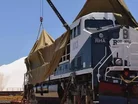Iron ore project Roy Hill looks to advance railway with new technology

The $10 billion Roy Hill project, which looks to produce iron ore through an integrated mine, rail and port operation in Western Australia, just secured a final piece to its railway.
Perth-based engineering company Lynxrail was selected to install its Automated Train Examiner (ATEx) technology for project’s independently owned and operated 344km standard gauge, single line, heavy haul railway. According to Mining Global, the contract with Lynxrail aims to integrate cutting-edge optics, electronics and machine vision algorithms to evaluate conditions of key rolling stock components while trains are running in service.
“The Roy Hill project will incorporate services such as Wheel Profile Monitor, Brake Shoe Monitor and the Hunting and Tracking Monitor, as well as an acoustic bearing monitor (RailBam), which ‘listens’ for faulty wheel bearings.”
• Related content: [VIDEO] Timelapse: Building the Roy Hill Project
The deal will help Roy Hill with a critical component for the project--keeping maintenance costs down while extending ore care wheel life.
“Wheels are one of the biggest costs in a railway,” said Roy Hill’s manager of rollingstock maintenance, Bruce Brymer. “At Roy Hill we are starting a new operation and we plan to maximise the life of our wheelsets. The ATEx and the RailBam will complement our Wheel Impact Load Detectors and Hot Bearing Detectors and provide continuous condition monitoring data for these key areas.”

Kris Kilian, the company’s founder and CEO, said the company has been developing the technology since the 1990s.
“We started with an idea to extend the life of the aging ore car fleets that were being used in the Pilbara at the time,” said Kilian.
• Related content: Inside the Making of Roy Hill
“To do this we had to have detailed information on the condition of key ore car components and we started taking photos of those components to develop a history of each vehicle.
“We have come a long way since then and the product that we will be using for Roy Hill is the result of thousands of hours of development work in the past 18 years.”
The Roy Hill project in the Pilbara region is expected to produce 55 million tons of iron ore annually. Hancock Prospecting holds the majority stake in the project with a 70 per cent interest, while the remaining 30 per cent stake is held by a consortia comprising POSCO (12.5 per cent), Marubeni (15 per cent), and China Steel (2.5 per cent).





